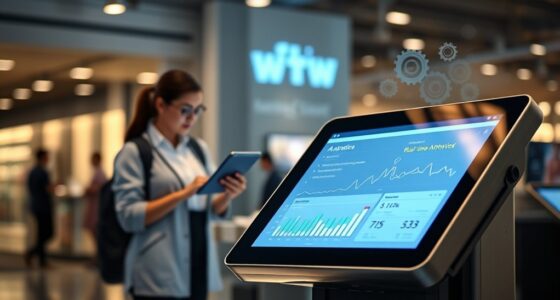By 2025, RPA will be revolutionized by advanced AI, making automation smarter and more capable of handling complex workflows. You’ll see bots that interpret unstructured data, make decisions, and optimize processes with minimal human oversight. This evolution empowers employees to shift focus from repetitive tasks to strategic activities, boosting productivity and innovation. As automation becomes more accessible and adaptive, organizations will gain a competitive edge—stay tuned to learn how these changes unfold.
Key Takeaways
- RPA will increasingly integrate advanced AI, enabling intelligent decision-making and handling unstructured data with minimal human oversight.
- Workforce automation will evolve, allowing employees to focus on strategic and creative tasks while bots manage repetitive processes.
- Complex workflows like customer service and compliance will be automated through smarter, context-aware RPA solutions.
- Democratized automation tools will empower non-technical staff to design and modify workflows, accelerating deployment.
- RPA solutions will become more scalable and adaptive, providing businesses with proactive, real-time operational insights.

As organizations continue to embrace digital transformation, Robotic Process Automation (RPA) is poised to evolve considerably by 2025. One of the most noteworthy shifts you’ll notice is the deepening integration of AI, which transforms RPA from simple task automation to intelligent decision-making systems. AI integration allows RPA bots to handle more complex processes, analyze data in real-time, and adapt to new scenarios without constant human intervention. This advancement means your workflows will become more efficient, reducing errors and freeing up your team to focus on strategic initiatives. Workforce automation will also accelerate as RPA tools become more sophisticated, seamlessly handling repetitive, rule-based tasks across various departments. You’ll see a shift where employees move away from monotonous duties, instead dedicating their time to higher-value activities like problem-solving, innovation, and customer engagement. This evolution in workforce automation doesn’t just improve productivity; it enhances job satisfaction as well, as your team can focus on more meaningful work.
By 2025, RPA will increasingly incorporate AI-driven cognitive capabilities. You’ll observe bots that can interpret unstructured data, such as emails or documents, and make decisions based on context—something that was difficult just a few years ago. This means your organization can automate more complex workflows, such as customer service interactions, compliance checks, and financial reconciliations, with minimal human oversight. The integration of AI also allows for predictive analytics within RPA processes, enabling you to anticipate issues before they arise and optimize operations proactively. As a result, your business will become more agile and responsive to market changes. Additionally, the rise of specialized automation tools will further streamline processes and reduce reliance on manual input, driving efficiency even higher.
Furthermore, you’ll notice that AI integration facilitates smarter workforce automation, empowering your employees to focus on tasks requiring emotional intelligence, creativity, and strategic thinking. As RPA tools evolve, they’ll become more user-friendly, with intuitive interfaces that allow non-technical staff to design and modify automation processes easily. This democratization of automation means you won’t need a team of specialists for every new task—your existing staff can adapt and expand RPA workflows rapidly. Overall, the combination of AI and workforce automation will lead to more scalable, flexible, and intelligent RPA solutions, substantially transforming how your organization operates by 2025. You’ll find yourself better equipped to handle the increasing demands of a digital-first world, gaining a competitive edge through smarter automation that adapts and learns over time.
Frequently Asked Questions
How Will RPA Impact Employment Rates in 2025?
In 2025, RPA will likely cause some job displacement, especially in repetitive task roles. However, you’ll find new opportunities opening up that require skill development in areas like automation management and data analysis. By upskilling, you’ll stay relevant and even thrive as RPA transforms workplaces. Embracing continuous learning will be key, helping you adapt to the changing job landscape and leverage automation for career growth.
What Industries Will Benefit Most From RPA Advancements?
Like a rising tide lifting all boats, industries embracing RPA will see the biggest benefits. You’ll find finance, healthcare, and manufacturing leading the charge, as they harness industry-specific automation to streamline processes. While technological adoption barriers may slow some, those who overcome them will release efficiency and innovation. RPA’s rapid evolution makes it a game-changer, transforming industries that adapt quickly into more agile, competitive players.
How Secure Is RPA Data Handling in 2025?
In 2025, RPA data handling is quite secure if you implement proper measures. You should rely on data encryption to protect sensitive information during transmission and storage. Additionally, access controls ensure only authorized users can access or modify data. When you combine these security features, RPA systems become much safer, reducing risks of data breaches and maintaining compliance, giving you confidence in your automation processes.
Will RPA Require New Regulatory Compliance Standards?
You’ll likely see new regulatory compliance standards for RPA in 2025, as a recent survey shows 68% of organizations anticipate regulatory updates due to evolving technology. RPA’s rapid adoption introduces compliance challenges that require proactive updates to existing standards. Staying ahead means adapting to these changes quickly, ensuring your automation processes meet current regulations while preparing for future compliance requirements. This will help you mitigate risks and maintain trust.
How Accessible Will RPA Technology Be for Small Businesses?
You’ll find RPA technology more accessible for small businesses, thanks to affordable solutions and user-friendly platforms. Vendors are focusing on simplifying deployment and reducing costs, making automation tools easier to adopt without extensive technical expertise. As a result, small businesses can now streamline processes, improve efficiency, and stay competitive without hefty investments, ensuring RPA becomes a practical option for organizations of all sizes in the near future.
Conclusion
As you embrace RPA in 2025, remember that automation isn’t just about efficiency—it’s about innovation. For example, a retail chain used RPA to handle customer inquiries, freeing staff to focus on personalized service. This shift boosted customer satisfaction and sales. Keep exploring emerging trends, invest in upskilling, and stay adaptable. By doing so, you’ll stay ahead in a rapidly evolving digital landscape, turning automation into your competitive advantage.









